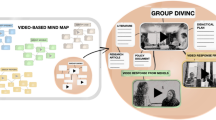Abstract
Traditionally, research on technology in mathematics education focuses on interactions between the user and the technology, but little is known about how technology can facilitate face-to-face interaction among students. We will explore the role that iPads versus traditional laptops play in shaping the learning spaces in which students explore concepts in business calculus. We will present a system for coding student interactions with the technology and fellow classmates during classroom observations. Our main result is that introducing the iPad, a portable device with a tactile interface and intuitive applications, enhances collaboration by allowing students to transition back and forth from private to public learning spaces.





Similar content being viewed by others
References
AP. (2006). Law professor bans laptops in class, over student protest. USA Today. http://www.usatoday.com/tech/news/2006-03-21-professor-laptop-ban_x.htm.
Chen, H. L., Lattuca, L. R., & Hamilton, E. R. (2008). Conceptualizing engagement: Contributions of faculty to student engagement in engineering. Journal of Engineering Education, 97(3), 339–353.
Chester, T. M. (2010). Cio predicament: What to do about the ipad. Campus Technology. URL http://campustechnology.com/articles/2010/05/05/cio-predicament-what-to-do-about-the-ipad.aspx.
Clark, J., & Paivio, A. (1991). Dual coding theory and education. Educational Psychology Review, 3, 149–210.
Cory, B. L., & Garofalo, J. (2011). Using dynamic sketches to enhance preservice secondary mathematics teachers’ understanding of limits of sequences. Journal for Research in Mathematics Education, 42(1), 65–97.
Dautenhahn, K., & Werry, I. (2004). Towards interactive robots in autism therapy: Background motivation and challenges. Pragmatics and Cognition, 12(1), 1–35.
della Cava, M. R. (2010). Does ipad have the magic to bring people together? USA Today. URL http://www.usatoday.com/life/lifestyle/2010-06-07-ipadculture07_CV_N.htm.
Drijvers, P., Kieran, C., Mariotti, M.-A., Ainley, J., Andresen, M., Chan, Y. C., et al. (2010). Integrating technology into mathematics education: Theoretical perspectives. In Mathematics education and technology-Rethinking the terrain, (pp. 89–132). Springer.
Drijvers, P., & Trouche, L. (2008). From artifacts to instruments: A theoretical framework behind the orchestra metaphor. Research on Technology and the Teaching and Learning of Mathematics, 2, 363–392.
Engeström, Y. (2001). Expansive learning at work: Toward an activity theoretical reconceptualization. Journal of Education and Work, 14(1), 133–156.
Engeström, Y., Miettinen, R., Punamäki, R.-L. (1999). Perspectives on activity theory. Cambridge: Cambridge University Press.
Ernest, P. (1994). The dialogical nature of mathematics. In P. Ernest (Ed.), Mathematics, education and philosophy: An international persective, vol. 3 of studies in mathematics education series. The Falmer Press.
Ernest, P. (2010). Reflections on theories of learning. In B. Sriraman, & L. English (Eds.), Theories of mathematics education: Seeking New Frontiers, Advances in Mathematics Education. Springer.
Fusch, D. (2011). Piloting the ipad. Academic Impressions. http://www.academicimpressions.com/news/piloting-ipad.
Güçler, B., Hegedus, S., Robidoux, R., & Jackiw, N. (2013). Investigating the mathematical discourse of young learners involved in multi-modal mathematical investigations: The case of haptic technologies. In D. Martinovic, V. Freiman, & Z. Karadag (Eds.), Visual Mathematics and Cyberlearning, vol. 1 of Mathematics Education in the Digital Era (pp. 97–118). Springer: Netherlands.
Graetz, K. A. (2006). The psychology of learning environments. In D. G. Oblinger (Ed.), Learning spaces, chap. 6. Educause. http://www.educause.edu/learningspaces.
Granott, N. (1993). Patterns of interaction in the co-construction of knowledge: Separate minds, joint effort, and weird creatures. In R. H. Wozniak, & K. W. Fisher (Eds.), Development in context: Acting and thinking in specific environments (pp. 183–207). Lawrence Erlbaum Associates.
Hall, E. T. (1966). The hidden dimension. Garden City, NY: Doubleday.
Harman, K. L., Humphrey, G. K., & Goodale, M. A. (1999). Active manual control of object views facilitates visual recognition. Current Biology, 9, 1315–1318.
Hegedus, S., & Moreno-Armella, L. (2011). The emergence of mathematical structures. Educational Studies in Mathematics, 77, 369–388.
Hu, W. (2011). Math that moves: Schools embrace the ipad. New York Times. http://www.nytimes.com/2011/01/05/education/05tablets.htm.
Jaimes, A., & Sebe, N. (2007). Multimodal human-computer interaction: A survey. Computer Vsion and Image Understanding, 108(1–2), 116–134.
James, K., Humphrey, G., Vilis, T., Corrie, B., Baddour, R., & Goodale, M. (2002). Active and passive learning of three-dimensional object structure within an immersive virtual reality environment. Behavior Research Methods, 34, 383–390.
Jones, K. (2000). Providing a foundation for deductive reasoning: Students’ interpretations when using dynamic geometry software and their evolving mathematical explanations. Educational Studies in Mathematics, 44, 55–85.
Kolowich, S. (2010). Apple of their eye? Inside Higher Ed. http://www.insidehighered.com/news/2010/12/22/college_students_test_drive_the_apple_ipad.
Lakoff, G., & Núñez, R. (2000). Where mathematics comes from: How the embodied mind brings mathematics into being. Basic Books.
Liu, C.-C., Chung, C.-W., Chen, N.-S., & Liu, B.-J. (2009). Analysis of peer interaction in learning activities with personal handhelds and shared displays. Educational Technology and Society, 12(3), 127–142.
Mayer, R. E., (2009). Multimedia learning. 2nd ed Cambridge: Cambridge University Press.
Moreno-Armella, L., & Hegedus, S. J. (2009). Co-action with digital technologies. ZDM, 41(4), 505–519.
Raines, J. M., & Clark, L. M. (2011). A brief overview on using technology to engage students in mathematics. Current Issues in Education, 14(2), 1–6.
Stieff, M., & Wilensky, U. (2003). Connected chemistryincorporating interactive simulations into the chemistry classroom. Journal of Science Education and Technology, 12, 285–302.
Sweller, J. (1999). Instructional design in technical areas. Melbourne: ACER Press.
Varela, F. J., Thompson, E., & Rosch, E. (1991). The embodied mind: Cognitive science and human experience. Cambridge, MA: MIT Press.
Vygotsky, L. S. (1978). Mind in society: Development of higher psychological processes. Cambridge, MA: Harvard University Press.
Vygotsky, L. S. (1986). Thought and language. Cambridge, MA: MIT Press.
Acknowledgments
We would like to thank Timothy Chester for initiating the iPad study at Pepperdine University and Dana Hoover and Janet Valencia for their involvement in conducting the university-wide study.
Author information
Authors and Affiliations
Corresponding author
Rights and permissions
About this article
Cite this article
Fisher, B., Lucas, T. & Galstyan, A. The Role of iPads in Constructing Collaborative Learning Spaces. Tech Know Learn 18, 165–178 (2013). https://doi.org/10.1007/s10758-013-9207-z
Published:
Issue Date:
DOI: https://doi.org/10.1007/s10758-013-9207-z




